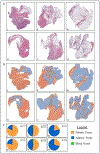Total Protein Staining is Superior to Classical or Tissue-Specific Protein Staining for Standardization of Protein Biomarkers in Heterogeneous Tissue Samples
- PMID: 32377595
- PMCID: PMC7202473
- DOI: 10.1016/j.genrep.2020.100641
Total Protein Staining is Superior to Classical or Tissue-Specific Protein Staining for Standardization of Protein Biomarkers in Heterogeneous Tissue Samples
Abstract
Protein detection techniques such as western blotting and ELISA rely on housekeeping proteins as standards for sample normalization. However, clinical or animal tissue specimens are heterogeneous due to presence of contaminating cell types and tissues (e.g., blood vessels and muscle) or cellular decay during tissue storage and isolation which may compromise protein integrity. This biological heterogeneity may invalidate the assumption that housekeeping proteins are invariable across various specimens. This study provides data that advocate for protein standardization based on total protein staining in rabbit posterior capsular tissues. We compared the classical normalization markers glyceraldehyde-3-phosphate dehydrogenase (GAPDH) and β-tubulin (TUBB) with other proteins that have low variation in expression (i.e., FTL, FTH1, EEF1A1, TPT1) based on RNAseq data for human posterior capsular tissues. Histological examination revealed a high degree of qualitative variation in microscopic images of capsular tissue specimens. This variation is reflected by significant differences in specific protein signals for all housekeeping proteins as detected by western blot analysis. However, total protein staining, which combines the intensity of multiple gel electrophoretic bands, normalizes natural biological variation observed for individual housekeeping proteins and permits assessment of protein integrity. Therefore, we propose that normalization based on total protein staining increases accuracy of protein quantification of heterogeneous tissue specimen samples.
Keywords: housekeeping; protein quantification; tissue samples; total protein.
Conflict of interest statement
Conflict of Interest: No benefits in any form have been received or will be received by any authors from a commercial party related directly or indirectly to the subject of this article.
Figures




Similar articles
-
Use of the REVERT® total protein stain as a loading control demonstrates significant benefits over the use of housekeeping proteins when analyzing brain homogenates by Western blot: An analysis of samples representing different gonadal hormone states.Mol Cell Endocrinol. 2018 Sep 15;473:156-165. doi: 10.1016/j.mce.2018.01.015. Epub 2018 Feb 1. Mol Cell Endocrinol. 2018. PMID: 29396126 Free PMC article.
-
GAPDH and β-actin protein decreases with aging, making Stain-Free technology a superior loading control in Western blotting of human skeletal muscle.J Appl Physiol (1985). 2015 Feb 1;118(3):386-94. doi: 10.1152/japplphysiol.00840.2014. Epub 2014 Nov 26. J Appl Physiol (1985). 2015. PMID: 25429098
-
Epicocconone staining: a powerful loading control for Western blots.Proteomics. 2014 Feb;14(2-3):162-8. doi: 10.1002/pmic.201300089. Proteomics. 2014. PMID: 24339236
-
Tubulin or Not Tubulin: Heading Toward Total Protein Staining as Loading Control in Western Blots.Proteomics. 2017 Oct;17(20). doi: 10.1002/pmic.201600189. Proteomics. 2017. PMID: 28941183 Review.
-
Western blotting revisited: critical perusal of underappreciated technical issues.Proteomics Clin Appl. 2015 Apr;9(3-4):396-405. doi: 10.1002/prca.201400118. Epub 2015 Mar 21. Proteomics Clin Appl. 2015. PMID: 25597284 Review.
Cited by
-
A critical path to producing high quality, reproducible data from quantitative western blot experiments.Sci Rep. 2022 Oct 20;12(1):17599. doi: 10.1038/s41598-022-22294-x. Sci Rep. 2022. PMID: 36266411 Free PMC article.
-
Age-related declines in mitochondrial Prdx6 contribute to dysregulated muscle bioenergetics.Redox Biol. 2025 Aug 5;86:103808. doi: 10.1016/j.redox.2025.103808. Online ahead of print. Redox Biol. 2025. PMID: 40774144 Free PMC article.
-
Western blotting (immunoblotting): history, theory, uses, protocol and problems.Biotechniques. 2023 Sep;75(3):99-114. doi: 10.2144/btn-2022-0034. Epub 2023 Mar 27. Biotechniques. 2023. PMID: 36971113 Free PMC article. Review.
-
Physiological Features of the Neural Stem Cells Obtained from an Animal Model of Spinal Muscular Atrophy and Their Response to Antioxidant Curcumin.Int J Mol Sci. 2024 Jul 31;25(15):8364. doi: 10.3390/ijms25158364. Int J Mol Sci. 2024. PMID: 39125934 Free PMC article.
-
Pharmacological target sites for restoration of age-associated deficits in NMDA receptor-mediated norepinephrine release in brain.J Neurochem. 2025 Jan;169(1):e16280. doi: 10.1111/jnc.16280. J Neurochem. 2025. PMID: 39655655 Free PMC article.
References
-
- Petrak J, Ivanek R, Toman O, Cmejla R, Cmejlova J, Vyoral D, et al. Deja vu in proteomics. A hit parade of repeatedly identified differentially expressed proteins. Proteomics. 2008. May;8(9):1744–9. Epub 2008/04/30. - PubMed
-
- Ferguson RE, Carroll HP, Harris A, Maher ER, Selby PJ, Banks RE. Housekeeping proteins: a preliminary study illustrating some limitations as useful references in protein expression studies. Proteomics. 2005. February;5(2):566–71. Epub 2005/01/04. - PubMed
-
- Thacker JS, Yeung DH, Staines WR, Mielke JG. Total protein or high-abundance protein: Which offers the best loading control for Western blotting? Analytical biochemistry. 2016. March 1;496:76–8. Epub 2015/12/27. - PubMed
-
- Moritz CP. Tubulin or Not Tubulin: Heading Toward Total Protein Staining as Loading Control in Western Blots. Proteomics. 2017. October;17(20). Epub 2017/09/25. - PubMed
-
- Lee HG, Jo J, Hong HH, Kim KK, Park JK, Cho SJ, et al. State-of-the-art housekeeping proteins for quantitative western blotting: Revisiting the first draft of the human proteome. Proteomics. 2016. July;16(13):1863–7. Epub 2016/04/30. - PubMed
Grants and funding
LinkOut - more resources
Full Text Sources
Research Materials
Miscellaneous
